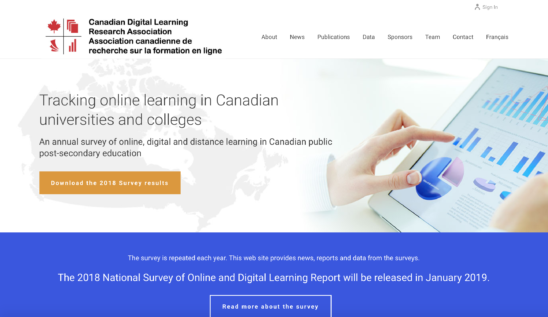The public report of the 2018 national survey of online and distance learning in Canadian universities and colleges is now available in English and French for free download on the survey web sites:
- https://onlinelearningsurveycanada.ca/publications-2018/
- https://formationenlignecanada.ca/publications-2018/
The full technical report will follow shortly.
Brief summary
I provided a summary of the main results in a post on December 20. In this post I intend to look at the implications. However, you may have missed my earlier post in pre-holiday preparations, so first here is an even briefer summary of the 2018 survey results (for the academic year 2016-2017):
- a very high response rate (80% of institutions covering 92% of all students), and better definitions, resulting in excellent quality data on online course enrolments and student numbers
- roughly 17% of all students are taking at least one online course; online course registrations account for 8% of all credit course enrolments; however, online learning is much less in the Québec college/CEGEP system than in the rest of the country
- online enrolments are steadily increasing each year, while overall enrolments are flat
- blended/hybrid learning is found in many institutions, but with relatively few courses to date, but it is also increasing;
- online learning is considered to be very or extremely important for the future in over two-thirds of all institutions; many institutional administrations believe blended/hybrid learning will be a significant teaching development in future years; but almost a third had no institutional strategy or plan for online learning
- nearly all institutions rated blended learning, and 87% of institutions rated online learning, as equal or superior to face-to-face teaching
- nearly all institutions reported that the main benefit of online learning was increased student access
- the main barriers to online learning were increased time for faculty/instructors and inadequate training and support
- interesting differences and similarities with data from comparable studies from the USA.
What does this mean?
Here, I will give my personal views on the results, which may not be shared by my colleagues in the survey team.
Online learning still a small but significant component of post-secondary teaching
First the actual number of online students and the online participation rates were lower than I expected, and less proportionately than in the USA: the latest data for U.S. higher education institutions shows that 33 percent of all students took at least one distance course as of fall 2017, a rate double that of Canada (Straut, 2018).
However, although their numbers have dropped dramatically in recent years, the for-profit universities in the USA such as the University of Phoenix and the not-for-profit private universities still account for a high proportion of online students (over 25%). Such institutions do not exist in Canada.
And 8% of all course enrolments is still significant, in terms of full-time equivalents. If online courses were to be replaced by campus-based teaching, this would require in Canada another four universities of 27,000 students, four colleges of 12,000, and a Cégep of 3,000. When one considers the high capital and operating costs of campuses, there are clearly significant cost efficiencies in absorbing extra enrolments through online learning – and in any case many of these students would not be able to take a campus-based course.
Furthermore in Canada online learning seems to be spread more evenly, with over two-thirds of the institutions offering online courses, whereas in the USA, online learning is dominated by several very large online universities and colleges, such as Arizona State University, Rio Salado Community College and the University of Southern New Hampshire, while in Canada the fully online universities and colleges such as Athabasca, Téluq and Cégep à Distance are much smaller and are actually losing enrolments to campus-based institutions now offering online courses and programs.
Less variation in quality than the USA?
Another result that surprised me was the relatively high appreciation of the quality of online and blended learning in Canadian post-secondary education. Most institutional leaders in Canada saw them as equal if not superior to conventional teaching, a sharp contrast to the USA where only 21% of the U.S.respondents believe that online credentials have the same level of respect as face-to-face credentials, compared to over one-half (54%) of the Canadian respondents.
My conclusion: online learning is more widespread institutionally and of less variation in quality in Canada than the USA. Where it is being done in Canada it is less open to ‘short-cuts’ and the use of armies of contract instructors than in the USA and is not tainted by the ‘for-profit’ reputation of some of the USA institutions that were often the early adopters of online learning in the USA. At the same time, Canadians may not be aware that in the USA it is the public, state institutions and the more prestigious not-for-profit private universities that are now the main drivers of credit-based online learning, and the gradually improving perception of the value of online learning.
I also want to point out that for all the tensions recently between Canada and the USA, this study highlighted the value of working closely with American colleagues. Frankly, the study would have been impossible without the major contributions of Jeff Seaman of the Babson Survey Research Group and Russ Poulin, of WCET. The survey results show that there is still much more in common between the USA and Canada than what divides us.
No room for complacency
Overall, in comparison with what I know about other jurisdictions such as the USA, Australia, the UK, and most of the rest of Europe, it seems to me that Canada is doing reasonably well in online and blended learning. Online learning has gained general acceptance and is widespread at a system level. Blended and hybrid learning is growing slowly and is reported to be resulting in more innovative teaching.
However, there are still major challenges to be overcome. The most important – and most difficult – is faculty resistance and lack of training. The two go hand in hand. Taking on a new way of teaching without adequate training is a major barrier to implementation and is likely to affect the quality of online learning. However, 73% of the institutions reported lack of adequate training for faculty was a barrier to online learning, and 85% considered that the extra work involved in teaching online was a barrier. Without improvement in this area, online and blended learning will continue to be under-developed.
I have written about this topic many times. It is not just training in the use of technology that faculty need (although this helps) but a better understanding of pedagogy and different possible approaches to teaching, and the advantages and limitations of different teaching approaches. Faculty training becomes even more important as faculty move into blended learning. Far too often I am seeing classroom lectures merely transferred to video delivery with very little adaptation, and little understanding of the needs of distance learners. It is not just a question of what – introducing pedagogy and different teaching approaches – but how: how to scale up the training when eventually all instructors will be using some form of blended learning.
This also relates to my last point: we need to move beyond seeing online learning as just improving access (as important as that is) to seeing it as a key tool for developing 21st century skills, especially digital skills, independent learning, critical thinking. and communication. This requires combining online learning with new pedagogical approaches: a challenge indeed.
Over to you
We (the survey research team) would love to get your comments and feedback on the report. When you have read it, please feel free to use the comment box below or send an email to me at tony.bates@ubc.ca
Reference
Straut, T. (2018) Distance Education Enrollment Growth—Major Differences Persist Among Sectors WCET Frontiers










 Dr. Tony Bates is the author of eleven books in the field of online learning and distance education. He has provided consulting services specializing in training in the planning and management of online learning and distance education, working with over 40 organizations in 25 countries. Tony is a Research Associate with Contact North | Contact Nord, Ontario’s Distance Education & Training Network.
Dr. Tony Bates is the author of eleven books in the field of online learning and distance education. He has provided consulting services specializing in training in the planning and management of online learning and distance education, working with over 40 organizations in 25 countries. Tony is a Research Associate with Contact North | Contact Nord, Ontario’s Distance Education & Training Network.


What makes you think that Australia is not doing reasonably well in online and blended learning? In 2017 external and multi modal students were 28.2% of all students, a modest increase on the 25.6% in 2015.
Australian Government Department of education and Training (2018) Selected higher education statistics – 2017 student data,
https://www.education.gov.au/selected-higher-education-statistics-2017-student-data
Hi, Gavin
I didn’t say that Australia is not doing reasonably well: ‘in comparison with what I know about other jurisdictions such as the USA, Australia, the UK, and most of the rest of Europe, it seems to me that Canada is doing reasonably well in online and blended learning’. Perhaps I should have said ‘holding its own.’
Also our data covers only online courses that are part of degree/diploma programs and does not cover external or continuing educations students – something we hope to add this year.